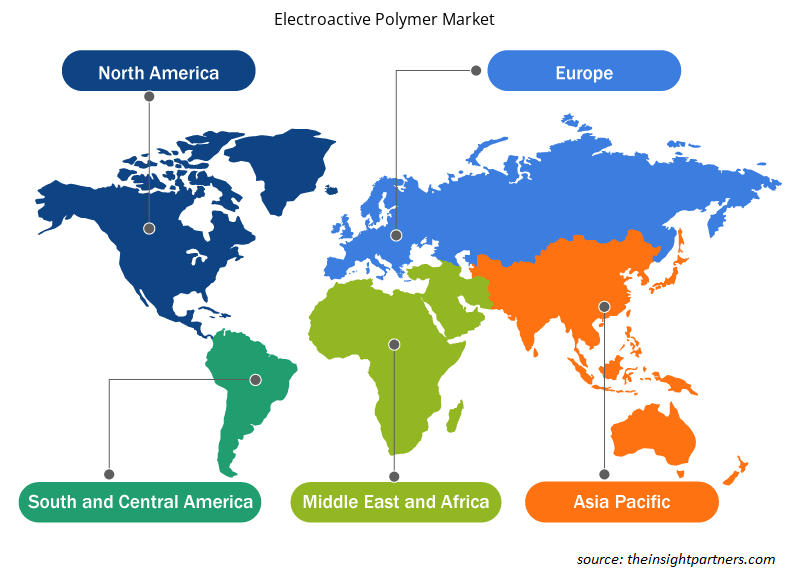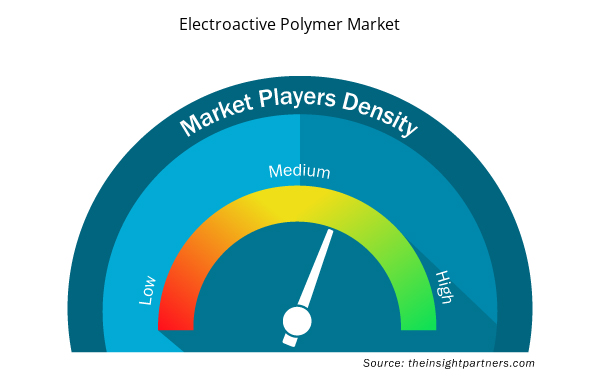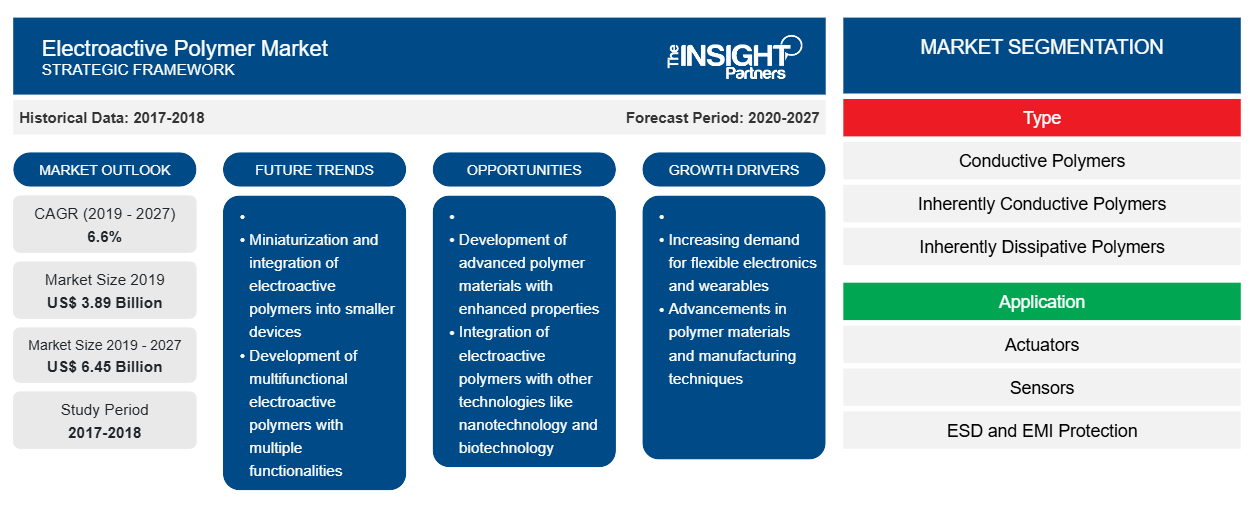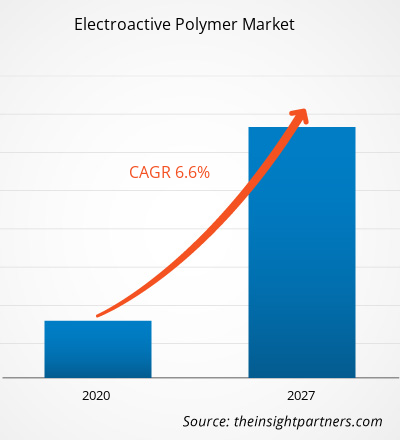Der Markt für elektroaktive Polymere wurde im Jahr 2019 auf 3.890,00 Millionen US-Dollar geschätzt und soll bis 2027 einen Wert von 6.449,55 Millionen US-Dollar erreichen; von 2020 bis 2027 wird mit einer durchschnittlichen jährlichen Wachstumsrate von 6,6 % gerechnet.
Der Markt für elektroaktive Polymere ist für Halbleiter- und Polymerhersteller äußerst profitabel, obwohl die Hersteller hohe Anfangsinvestitionen tätigen müssten, um von Silizium auf Polymere umzusteigen. Es gibt mehrere Kräfte, die den Markt für elektroaktive Polymere beeinflussen. Die Kosten sind der wichtigste Faktor, der das Wachstum der Branche für elektroaktive Polymere vorantreibt. Die Verwendung von Polymeren in Leucht- und Roboteranwendungen ist kostengünstiger als die Verwendung von Halbleiter- und Metallmaterialien. Die Verwendung elektroaktiver Polymere im Bereich der Biomedizin und Biomimetik könnte dazu beitragen, das globale Problem der steigenden Gesundheitskosten zu lösen.
Im Jahr 2019 ist der asiatisch-pazifische Raum der größte Markt für elektroaktive Polymere. Der größte Marktanteil der Region für elektroaktive Polymere ist in erster Linie auf die Präsenz etablierter Akteure wie 3M, Arkema Group und Solvay SA zurückzuführen. Diese Länder verzeichnen eine steigende Nachfrage in der Fertigungs- und Automobilindustrie. Neben der Anwendung elektroaktiver Polymere in der Automobilindustrie werden elektroaktive Polymere in großem Umfang in medizinischen Geräten, Flugzeugen, Elektronik und Haushaltsgeräten, der Industrie und anderen Branchen eingesetzt. Diese breitere Anwendung elektroaktiver Polymere in den Endverbrauchsindustrien dieser Region beeinflusst das Marktwachstum weiter.
Der COVID-19-Ausbruch begann im Dezember 2019 in Wuhan (China) und hat sich seitdem rasant über den ganzen Globus verbreitet. Im März 2021 waren die USA, Indien, Brasilien, Russland, Großbritannien, Frankreich, Spanien, Italien, die Türkei, Deutschland, Kolumbien und Argentinien hinsichtlich bestätigter Fälle und gemeldeter Todesfälle am schlimmsten betroffen. Den jüngsten Zahlen der WHO zufolge gab es am 18. März 2021 weltweit 120.915.219 bestätigte Fälle und insgesamt 2.674.078 Todesfälle. Der COVID-19-Ausbruch hat aufgrund von Lockdowns, Reiseverboten und Betriebsschließungen die Volkswirtschaften und Industrien zahlreicher Länder beeinträchtigt. Die Chemie- und Werkstoffindustrie gehört zu den wichtigsten Branchen, die infolge dieses Ausbruchs unter schweren Störungen wie Lieferkettenunterbrechungen, Schließungen von Produktionsanlagen usw. leiden. Die Schließung verschiedener Anlagen und Fabriken in führenden Regionen wie Nordamerika, Europa, Asien-Pazifik, Südamerika sowie dem Nahen Osten und Afrika hat die globale Lieferkette beeinträchtigt und sich negativ auf die Herstellung, Lieferpläne und den Verkauf verschiedener Chemikalien und Materialien ausgewirkt. Darüber hinaus haben verschiedene Unternehmen bereits mögliche Verzögerungen bei Produktlieferungen und einen Einbruch der zukünftigen Verkäufe ihrer Produkte angekündigt. Darüber hinaus beeinträchtigen die von Ländern in Europa, Asien und Nordamerika verhängten globalen Reiseverbote die Möglichkeiten für Geschäftskooperationen und Partnerschaften. All diese Faktoren werden sich voraussichtlich negativ auf die Chemie- und Materialindustrie auswirken und somit in den kommenden Monaten als hemmender Faktor für das Wachstum verschiedener mit dieser Industrie verbundener Märkte wirken.
Passen Sie diesen Bericht Ihren Anforderungen an
Sie erhalten kostenlos individuelle Anpassungen an jedem Bericht, einschließlich Teilen dieses Berichts oder einer Analyse auf Länderebene, eines Excel-Datenpakets sowie tolle Angebote und Rabatte für Start-ups und Universitäten.
- Holen Sie sich die wichtigsten Markttrends aus diesem Bericht.Dieses KOSTENLOSE Beispiel umfasst eine Datenanalyse von Markttrends bis hin zu Schätzungen und Prognosen.
Markteinblicke
Steigende Nachfrage nach intelligenter Elektronik
Entwicklungen in Wissenschaft und Technologie, insbesondere im Elektronik- und Halbleitersektor, haben zur Entwicklung intelligenter Polymere geführt, die bei Stromanregung ihre Form ändern können. Smartphones sind ein Paradebeispiel für intelligente Elektronik, die Komponenten aus elektroaktiven Polymeren verwendet, wie Batterien, Kondensatoren, Näherungssensoren, Fingerabdrucksensoren und Touchscreen-Sensoren. Elektroaktive Polymere werden auch in intelligenten Computern, Laptops und Tablets verwendet. Mit den laufenden Forschungs- und Entwicklungsaktivitäten werden Unternehmen wahrscheinlich auf die Verwendung elektroaktiver Polymere in Computern für Blinde mittels Brailleschrift kommen. Elektroaktive Polymere werden in elektronischen Geräten verwendet, um die Zeichenbegrenzung bei der Verwendung von Brailleschrift zu erweitern und so sehbehinderten Menschen bei der Kommunikation zu helfen. Laut einem Bericht von The Insight Partners wird der globale Markt für intelligente Elektronik im Zeitraum 2020–2027 voraussichtlich eine bemerkenswerte durchschnittliche jährliche Wachstumsrate von ~7 % verzeichnen, was ein großes Potenzial für elektroaktive Polymere in intelligenter Elektronik darstellt.
Typ-Einblicke
Basierend auf dem Typ ist der Markt für elektroaktive Polymere in leitfähige Kunststoffe, inhärent leitfähige Polymere, inhärent dissipative Polymere und andere unterteilt. Das Segment der inhärent leitfähigen Polymere führte den Markt für elektroaktive Polymere mit dem höchsten Marktanteil im Jahr 2019 an. Das inhärent leitfähige Polymer ist eine Familie spezieller leitfähiger thermoplastischer Verbindungen, die einen gleichmäßigen und präzisen Oberflächenwiderstand über ein Widerstandsspektrum von starker elektrostatischer Entladung bis starker Antistatik aufweisen. Diese Polymere eignen sich gut für Festplattenkomponenten, Waferverarbeitung und Reinraumanwendungen. Sie sind vorteilhaft in Automobilanwendungen, die einen Schutz vor statischer Entladung benötigen, wie z. B. Kraftstoffsystemkomponenten. Andere Automobilanwendungen dieser Polymere sind Karosserieanbauteile wie Spiegelgehäuse, Türgriffe, Stoßstangen, Radkappen, Kotflügel und Innenraumteile.
Anwendungseinblicke
Basierend auf der Anwendung ist der Markt für elektroaktive Polymere in Aktuatoren, Sensoren, ESD- und EMI-Schutz, antistatische Verpackung, Robotik und andere unterteilt. Das Segment ESD- und EMI-Schutz führte den Markt für elektroaktive Polymere mit dem höchsten Marktanteil im Jahr 2019 an. Nebenwirkungen, die durch eine elektrostatische Entladung (ESD) verursacht werden, sind eine induzierte EMI (elektromagnetische Interferenz). Die Auswirkungen unerwünschter elektromagnetischer Strahlung oder EMI auf ungeerdete oder ungeschirmte Leiter werden häufig unterschätzt. Ein ESD-Schutzgerät kann einen Schaltkreis vor einer elektrostatischen Entladung (ESD) schützen, um eine Fehlfunktion oder einen Ausfall eines elektronischen Geräts zu verhindern. Elektroaktive Polymere werden in solchen Geräten zum EDS-Schutz verwendet, da diese Polymere eine hohe physikalische und mechanische Festigkeit sowie antistatische Eigenschaften aufweisen.
Lubrizol Corporation; Arkema Group; Solvay SA; Parker Hannifin Corp; Celanese Corporation; Avient Corporation; Agfa-Gevaert Group; Kenner Material & System Co., Ltd.; 3M; und Premix Group gehören zu den wichtigsten Marktteilnehmern. Wichtige Akteure auf dem Markt für elektroaktive Polymere konzentrieren sich auf Strategien wie Fusionen und Übernahmen sowie Produkteinführungen, um die geografische Präsenz und die Verbraucherbasis weltweit zu erhöhen.
Bericht-Spotlights
- Fortschrittliche Branchentrends auf dem globalen Markt für elektroaktive Polymere helfen den Akteuren bei der Entwicklung wirksamer langfristiger Strategien
- In Industrie- und Entwicklungsländern angewandte Strategien für Unternehmenswachstum
- Quantitative Analyse des globalen Marktes für elektroaktive Polymere von 2017 bis 2027
- Schätzung der Nachfrage nach elektroaktiven Polymeren in verschiedenen Branchen
- PEST-Analyse zur Veranschaulichung der Wirksamkeit der in der Branche tätigen Käufer und Lieferanten bei der Vorhersage des Marktwachstums
- Aktuelle Entwicklungen zum Verständnis des Wettbewerbsmarktszenarios und der Nachfrage nach elektroaktiven Polymeren
- Markttrends und -aussichten in Verbindung mit Faktoren, die das Wachstum des Marktes für elektroaktive Polymere vorantreiben und bremsen
- Entscheidungsprozess durch das Verständnis von Strategien, die das kommerzielle Interesse im Hinblick auf das globale Wachstum des Marktes für elektroaktive Polymere untermauern
- Marktgröße für elektroaktive Polymere an verschiedenen Marktknoten
- Detaillierte Übersicht und Segmentierung des globalen Marktes für elektroaktive Polymere sowie seiner Dynamik in der Branche
- Marktgröße für elektroaktive Polymere in verschiedenen Regionen mit vielversprechenden Wachstumschancen
Regionale Einblicke in den Markt für elektroaktive Polymere
Die regionalen Trends und Faktoren, die den Markt für elektroaktive Polymere im gesamten Prognosezeitraum beeinflussen, wurden von den Analysten von Insight Partners ausführlich erläutert. In diesem Abschnitt werden auch die Marktsegmente und die Geografie für elektroaktive Polymere in Nordamerika, Europa, im asiatisch-pazifischen Raum, im Nahen Osten und Afrika sowie in Süd- und Mittelamerika erörtert.

- Erhalten Sie regionalspezifische Daten zum Markt für elektroaktive Polymere
Umfang des Marktberichts über elektroaktive Polymere
| Berichtsattribut | Details |
|---|---|
| Marktgröße im Jahr 2019 | 3,89 Milliarden US-Dollar |
| Marktgröße bis 2027 | 6,45 Milliarden US-Dollar |
| Globale CAGR (2019 - 2027) | 6,6 % |
| Historische Daten | 2017-2018 |
| Prognosezeitraum | 2020–2027 |
| Abgedeckte Segmente | Nach Typ
|
| Abgedeckte Regionen und Länder | Nordamerika
|
| Marktführer und wichtige Unternehmensprofile |
|
Dichte der Marktteilnehmer für elektroaktive Polymere: Auswirkungen auf die Geschäftsdynamik verstehen
Der Markt für elektroaktive Polymere wächst rasant, angetrieben durch die steigende Nachfrage der Endnutzer aufgrund von Faktoren wie sich entwickelnden Verbraucherpräferenzen, technologischen Fortschritten und einem größeren Bewusstsein für die Vorteile des Produkts. Mit steigender Nachfrage erweitern Unternehmen ihr Angebot, entwickeln Innovationen, um die Bedürfnisse der Verbraucher zu erfüllen, und nutzen neue Trends, was das Marktwachstum weiter ankurbelt.
Die Marktteilnehmerdichte bezieht sich auf die Verteilung der Firmen oder Unternehmen, die in einem bestimmten Markt oder einer bestimmten Branche tätig sind. Sie gibt an, wie viele Wettbewerber (Marktteilnehmer) in einem bestimmten Marktraum im Verhältnis zu seiner Größe oder seinem gesamten Marktwert präsent sind.
Die wichtigsten auf dem Markt für elektroaktive Polymere tätigen Unternehmen sind:
- 3M Unternehmen
- Agfa-Gevaert-Gruppe
- Arkema SA
- Celanese Corporation
- Kenner Material und System Co. Ltd.
Haftungsausschluss : Die oben aufgeführten Unternehmen sind nicht in einer bestimmten Reihenfolge aufgeführt.

- Überblick über die wichtigsten Akteure auf dem Markt für elektroaktive Polymere
Globaler Markt für elektroaktive Polymere, nach Typ
- Leitfähige Polymere
- Inhärent leitfähige Polymere
- Inhärent dissipative Polymere
- Sonstiges
Globaler Markt für elektroaktive Polymere, nach Anwendung
- Aktuatoren
- Sensoren
- ESD- und EMI-Schutz
- Antistatische Verpackung
- Sonstiges
Firmenprofile
- Lubrizol Corporation
- Arkema-Gruppe
- Solvay SA
- Parker Hannifin Corp
- Celanese Corporation
- Avient Corporation
- Agfa-Gevaert-Gruppe
- Kenner Material & System Co., Ltd.
- 3M
- Premix-Gruppe
- Historische Analyse (2 Jahre), Basisjahr, Prognose (7 Jahre) mit CAGR
- PEST- und SWOT-Analyse
- Marktgröße Wert/Volumen – Global, Regional, Land
- Branche und Wettbewerbsumfeld
- Excel-Datensatz


- Pressure Vessel Composite Materials Market
- Semiconductor Metrology and Inspection Market
- Water Pipeline Leak Detection System Market
- GNSS Chip Market
- Helicopters Market
- Medical and Research Grade Collagen Market
- Hair Wig Market
- Hot Melt Adhesives Market
- Identity Verification Market
- EMC Testing Market

Report Coverage
Revenue forecast, Company Analysis, Industry landscape, Growth factors, and Trends

Segment Covered
This text is related
to segments covered.

Regional Scope
North America, Europe, Asia Pacific, Middle East & Africa, South & Central America

Country Scope
This text is related
to country scope.
Häufig gestellte Fragen
Electrically conductive & static dissipative plastics guard components from failures also breakage prompted by uncontrolled electrostatic discharge (ESD) in electronics production & logistics. The electroactive plastics guarantee longer operating life for electronic devices. Conductive particles such as graphite and nanofillers are uniquely attractive to be applied as cases of electronic devices with electrostatic discharge properties (ESD) and electromagnetic shielding (EMI). Another attractive employment with a high technology result of conductive plastics is their potentialities as electronic sensors, actuators, which also react against an external stimulus, in this case, a deformation. The biggest advantage of electroactive polymers is their processability, mainly through dispersion. Some of the conductive plastics are polycarbazoles, polyindoles, polyazepines, and others.
The major players operating in the global avocado oil market are Lubrizol Corporation, Arkema Group, Solvay S.A., Parker Hannifin Corp, Celanese Corporation, Avient Corporation, Agfa-Gevaert Group, Kenner Material & System Co., Ltd., 3M, and Premix Group.
In 2019, Asia Pacific contributed to the largest share in the global electroactive polymer market. The market for electroactive polymers in APAC is witnessing growth owing to owing to the growing demand for the consumer electronics industry in the region. Furthermore, the growing urbanization coupled with the increasing population in Asia Pacific countries such as China, India, Japan, and South Korea is the major factor driving the demand for electroactive polymers. Moreover, North America also holds a significant market share of the electroactive polymers market owing to the rising medical device industry. According to the Select USA, the U.S. medical device industry is projected to rise to $208 billion by the year 2023. Therefore, with the growing medical device industry, the demand for electroactive polymers will also subsequently increase, which is projected to fuel the electroactive polymers industry in the North America and Asia Pacific during the forecast period.
Trends and growth analysis reports related to Chemicals and Materials : READ MORE..
The List of Companies - Electroactive Polymer Market
- 3M Company
- Agfa-Gevaert Group
- Arkema S.A.
- Celanese Corporation
- Kenner Material and System Co. Ltd.
- NOVASENTIS, INC
- Parker-Hannifin Corporation
- PolyOne Corporation
- Solvay SA
- The Lubrizol Corporation
The Insight Partners performs research in 4 major stages: Data Collection & Secondary Research, Primary Research, Data Analysis and Data Triangulation & Final Review.
- Data Collection and Secondary Research:
As a market research and consulting firm operating from a decade, we have published and advised several client across the globe. First step for any study will start with an assessment of currently available data and insights from existing reports. Further, historical and current market information is collected from Investor Presentations, Annual Reports, SEC Filings, etc., and other information related to company’s performance and market positioning are gathered from Paid Databases (Factiva, Hoovers, and Reuters) and various other publications available in public domain.
Several associations trade associates, technical forums, institutes, societies and organization are accessed to gain technical as well as market related insights through their publications such as research papers, blogs and press releases related to the studies are referred to get cues about the market. Further, white papers, journals, magazines, and other news articles published in last 3 years are scrutinized and analyzed to understand the current market trends.
- Primary Research:
The primarily interview analysis comprise of data obtained from industry participants interview and answers to survey questions gathered by in-house primary team.
For primary research, interviews are conducted with industry experts/CEOs/Marketing Managers/VPs/Subject Matter Experts from both demand and supply side to get a 360-degree view of the market. The primary team conducts several interviews based on the complexity of the markets to understand the various market trends and dynamics which makes research more credible and precise.
A typical research interview fulfils the following functions:
- Provides first-hand information on the market size, market trends, growth trends, competitive landscape, and outlook
- Validates and strengthens in-house secondary research findings
- Develops the analysis team’s expertise and market understanding
Primary research involves email interactions and telephone interviews for each market, category, segment, and sub-segment across geographies. The participants who typically take part in such a process include, but are not limited to:
- Industry participants: VPs, business development managers, market intelligence managers and national sales managers
- Outside experts: Valuation experts, research analysts and key opinion leaders specializing in the electronics and semiconductor industry.
Below is the breakup of our primary respondents by company, designation, and region:

Once we receive the confirmation from primary research sources or primary respondents, we finalize the base year market estimation and forecast the data as per the macroeconomic and microeconomic factors assessed during data collection.
- Data Analysis:
Once data is validated through both secondary as well as primary respondents, we finalize the market estimations by hypothesis formulation and factor analysis at regional and country level.
- Macro-Economic Factor Analysis:
We analyse macroeconomic indicators such the gross domestic product (GDP), increase in the demand for goods and services across industries, technological advancement, regional economic growth, governmental policies, the influence of COVID-19, PEST analysis, and other aspects. This analysis aids in setting benchmarks for various nations/regions and approximating market splits. Additionally, the general trend of the aforementioned components aid in determining the market's development possibilities.
- Country Level Data:
Various factors that are especially aligned to the country are taken into account to determine the market size for a certain area and country, including the presence of vendors, such as headquarters and offices, the country's GDP, demand patterns, and industry growth. To comprehend the market dynamics for the nation, a number of growth variables, inhibitors, application areas, and current market trends are researched. The aforementioned elements aid in determining the country's overall market's growth potential.
- Company Profile:
The “Table of Contents” is formulated by listing and analyzing more than 25 - 30 companies operating in the market ecosystem across geographies. However, we profile only 10 companies as a standard practice in our syndicate reports. These 10 companies comprise leading, emerging, and regional players. Nonetheless, our analysis is not restricted to the 10 listed companies, we also analyze other companies present in the market to develop a holistic view and understand the prevailing trends. The “Company Profiles” section in the report covers key facts, business description, products & services, financial information, SWOT analysis, and key developments. The financial information presented is extracted from the annual reports and official documents of the publicly listed companies. Upon collecting the information for the sections of respective companies, we verify them via various primary sources and then compile the data in respective company profiles. The company level information helps us in deriving the base number as well as in forecasting the market size.
- Developing Base Number:
Aggregation of sales statistics (2020-2022) and macro-economic factor, and other secondary and primary research insights are utilized to arrive at base number and related market shares for 2022. The data gaps are identified in this step and relevant market data is analyzed, collected from paid primary interviews or databases. On finalizing the base year market size, forecasts are developed on the basis of macro-economic, industry and market growth factors and company level analysis.
- Data Triangulation and Final Review:
The market findings and base year market size calculations are validated from supply as well as demand side. Demand side validations are based on macro-economic factor analysis and benchmarks for respective regions and countries. In case of supply side validations, revenues of major companies are estimated (in case not available) based on industry benchmark, approximate number of employees, product portfolio, and primary interviews revenues are gathered. Further revenue from target product/service segment is assessed to avoid overshooting of market statistics. In case of heavy deviations between supply and demand side values, all thes steps are repeated to achieve synchronization.
We follow an iterative model, wherein we share our research findings with Subject Matter Experts (SME’s) and Key Opinion Leaders (KOLs) until consensus view of the market is not formulated – this model negates any drastic deviation in the opinions of experts. Only validated and universally acceptable research findings are quoted in our reports.
We have important check points that we use to validate our research findings – which we call – data triangulation, where we validate the information, we generate from secondary sources with primary interviews and then we re-validate with our internal data bases and Subject matter experts. This comprehensive model enables us to deliver high quality, reliable data in shortest possible time.


 Holen Sie sich ein kostenloses Muster für diesen Bericht
Holen Sie sich ein kostenloses Muster für diesen Bericht